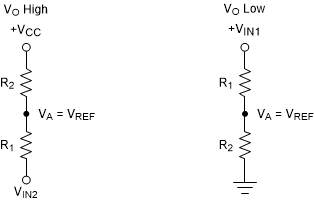ZHCSOE4A december 2022 – august 2023 TLV1851 , TLV1861
PRODMIX
- 1
- 1 特性
- 2 应用
- 3 说明
- 4 Revision History
- 5 Pin Configuration and Functions
- 6 Specifications
- 7 Detailed Description
- 8 Application and Implementation
- 9 Layout
- 10器件和文档支持
- 11Mechanical, Packaging, and Orderable Information
8.1.2.2 Non-Inverting Comparator With Hysteresis
A non-inverting comparator with hysteresis requires a two-resistor network and a voltage reference (VREF) at the inverting input, as shown in Figure 8-5,
 Figure 8-5 TLV185x in a Non-Inverting Configuration With Hysteresis
Figure 8-5 TLV185x in a Non-Inverting Configuration With HysteresisThe equivalent resistor networks when the output is high and low are shown in Figure 8-6.
 Figure 8-6 Non-Inverting Configuration Resistor Networks
Figure 8-6 Non-Inverting Configuration Resistor NetworksWhen VIN is less than VREF,, the output is low. For the output to switch from low to high, VIN must rise above the VIN1 threshold. Use Equation 4 to calculate VIN1.

When VIN is greater than VREF, the output is high. For the comparator to switch back to a low state, VIN must drop below VIN2. Use Equation 5 to calculate VIN2.

The hysteresis of this circuit is the difference between VIN1 and VIN2, as shown in Equation 6.

For more information, please see Application Notes SNOA997 "Inverting comparator with hysteresis circuit" and SBOA313 "Non-Inverting Comparator With Hysteresis Circuit".